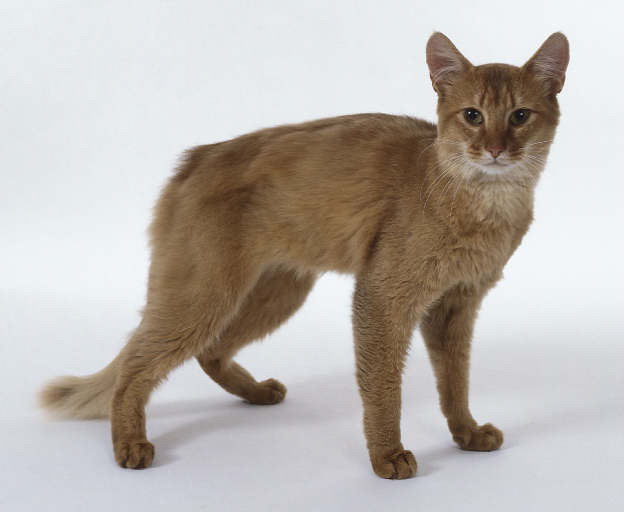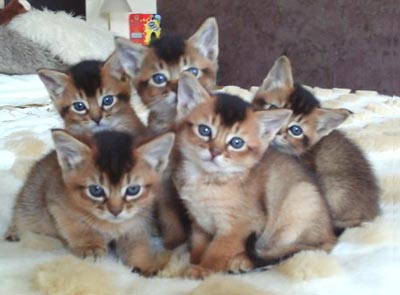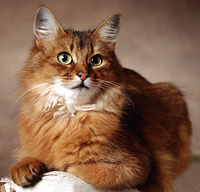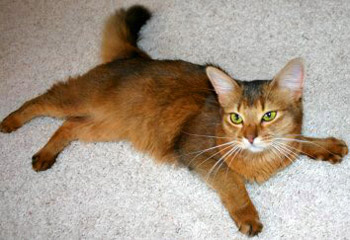



|
Somali Cat Description
The Somali is a slow maturing breed, usually taking up to 18 months to fully develop the coat and color. The coat should be soft to the touch, extremely fine and double coated; the denser the coat the better. The length of the coat should be medium with a longer ruff and breeches. This is an agouti or ticked breed, which means each hair will show banding. Banding is the stacking of colors on each strand of hair with the lighter color against the skin and a dark tip. The coat of the Somali should possess even ticking that gives the coat a warm and glowing appearance. There are four accepted colors: ruddy, red, blue and fawn.
The head of the Somali is a modified, slightly rounded wedge with a full chin and gently contoured muzzle. The ears should be large and alert, moderately pointed and broad; tufts are desirable. Eyes should be almond shaped, large and brilliant in color. They should lend an expressive look and be accentuated by dark lid skin and a light color around the eyes.
Somali's are long, lithe and graceful, displaying well-developed muscular strength. The back is slightly arched, giving the appearance of a cat about to spring. They should strike a medium between the cobby and svelte types. Legs should be in proportion and give them impression of a nimble and quick cat on oval and compact feet.
Somali Cat Temperament
The Somali is soft voiced, usually communicating through soft mews and a charming trill. They are very extroverted and social, loving to play and nuzzle. They give in to random spurts of energy that will have them charging through the house and leaping into the air; they will even run sideways and carry things in their mouths like monkeys. They can open cupboards and drawers; many turn on water faucets and love playing with water.
Somali Cat Care
An agouti breed, they are susceptible to gingivitis, tooth decay, and the renal disease amyloidosis. Regular check ups with an animal health professional are recommended.
Somali Cat History
The Somali is believed by many to be a spontaneous mutation of the Abyssinian; however, genetic studies indicate that it is more likely that turn of the century breeders used long-hared cats in their Abyssinian breeding programs; because the gene for long hair is recessive, two shorthairs may produce a long hair but two long hairs will never produce a short hair. World War I and World War II decimated the European cat populations, and many breeders were forced to outcross in order to preserve the breeds they worked with.
In 1953, Raby Chuffa of Selene was sent to the United States from Britain. He is the male Abyssinian considered to be the father of the Somali breed. Before 1960, most long-haired Abyssinians were quietly disposed of, but breeders in the U.S. saw something special in Chuffa and began to breed the long-haired Abyssinian with great gusto. European breeders saw the way the public was drawn to these long-haired versions and began trying to turn their own castaway kittens into their own breed.
The Somali received Championship status with the CFA in 1978
|